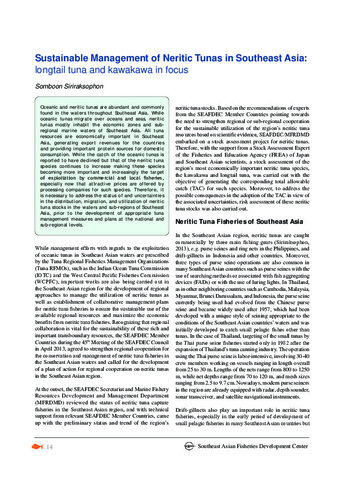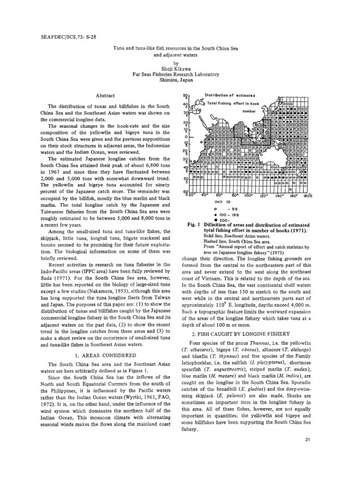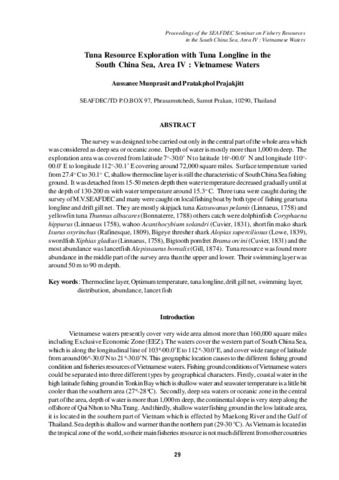Scientific Report on Stock Assessments of Yellowfin Tuna (Thunnus albacares), Bigeye Tuna (Thunnus obesus) and Skipjack Tuna (Katsuwonus pelamis) in Sulu and Sulawesi Seas by ASPIC
Share
นามธรรม
Results of stock assessments should be looked at with caution because of following reasons, i.e., (a) Stock assessments (YFT: yellowfin, BET: bigeye and SKJ: skipjack tuna) in the SSS water, may not be meaningful because they are small parts of Western and Central Pacific stocks (see Fig. 2), thus catch in SSS are about 19% (YFT), 12% (BET) and 14% (SKJ) of the catches in WCPFC water. But results may represent the stock status in the local (SSS) situation in some extent if emigration and immigration between the SSS water and WCPFC water are constant, (b) there are 23 years of catch in SSS, which are long enough for stock assessments. But aggregated catch of various species are often disaggregated to catch by species using average species compositions, which may produce biased in the estimated catch by species, (c) stock assessments were conducted by ASPIC without biological data and stock-recruit relationship, which may mask real population dynamics which may mislead the Kobe plot (stock status trajectories) and (d) results are highly relied on CPUE that is available only for 10 years, thus results are very sensitive by trends and/or jumps of CPUE series.
การอ้างอิง
SEAFDEC. (2017). Scientific report on stock assessments of yellowfin tuna (Thunnus albacares), bigeye tuna (Thunnus obesus) and skipjack tuna (Katsuwonus pelamis) in Sulu and Sulawesi Seas by ASPIC* (*A Stock Production Model Incorporating Covariates). Samut Prakarn, Thailand: Training Department, Southeast Asian Fisheries Development Center.
คอลเลกชัน
- SEAFDEC/TD [12]
รายการที่เกี่ยวข้อง
แสดงรายการที่เกี่ยวข้องตามชื่อผู้แต่งผู้สร้างและเรื่อง
-
Sustainable management of neritic tunas in Southeast Asia: Longtail tuna and kawakawa in focus
Siriraksophon, Somboon (Secretariat, Southeast Asian Fisheries Development Center, 2017)Oceanic and neritic tunas are abundant and commonly found in the waters throughout Southeast Asia. While oceanic tunas migrate over oceans and seas, neritic tunas mostly inhabit the economic zones and subregional marine ... -
Tuna and tuna-like fish resources in the South China Sea and adjacent waters
Kikawa, Shoji (Japan International Cooperation Agency, 1977)The distribution of tunas and billfishes in the South China Sea and the Southeast Asian waters was shown on the commercial longline data. The seasonal changes in the hook-rate and the size composition of the yellowfin and ... -
Tuna resource exploration with tuna longline in the South China Sea, Area IV: Vietnamese waters
Munprasit, Aussanee; Prajakjitt, Pratakphol (Secretariat, Southeast Asian Fisheries Development Center, 2001)The survey was designed to be carried out only in the central part of the whole area which was considered as deep sea or oceanic zone. Depth of water is mostly more than 1,000 m deep. The exploration area was covered from ...




